16 Benefits Of Kale, Nutrition, Recipes, Uses, And Risks
Detoxifier, antioxidant, and health promoter – this leafy green wears many hats.
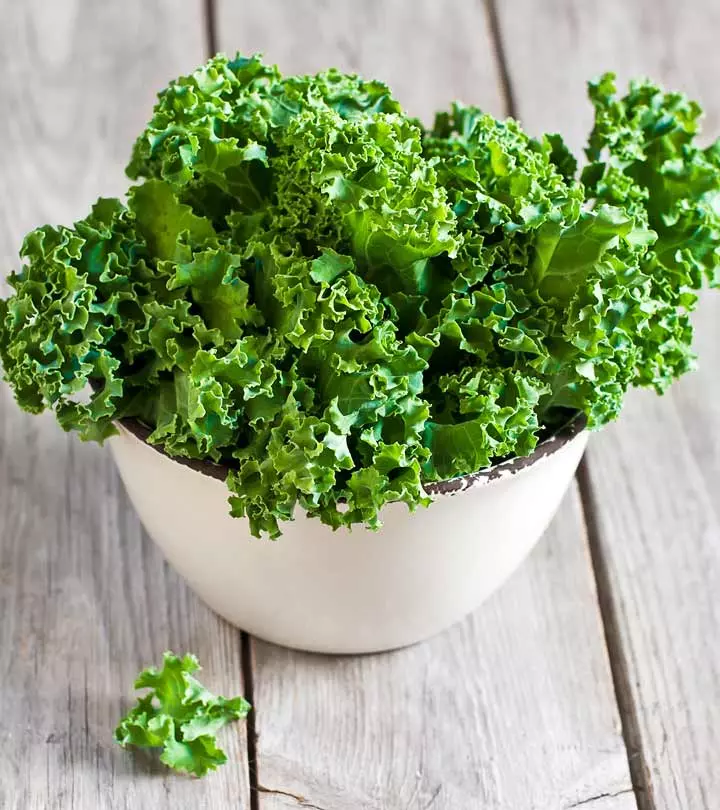
Image: i Stock
Queen of the greens – we certainly address kale this way because kale benefits your health in multiple ways. It is also becoming known as the new beef due to the rising popularity of plant-based superfoods all over the world.
You can add kale to your daily diet to boost your health. Want to know how? Read this article to get all the info about this green, leaf vegetable and what wonders it can do for your body. Scroll down!
 Know Your Ingredient: Kale
Know Your Ingredient: KaleWhat Is It?
A green, leafy, cruciferous vegetable.
What Are Its Benefits?
Plays a key role in cancer prevention, promotes heart health, improves blood sugar levels, and fights inflammation.
Who Can Use It?
People with high blood sugar levels, inflammations, and low bone mineral density.
How Often?
A serving size of kale is around 1 cup of raw kale or half a cup of cooked kale every day.
Caution
Excess consumption may cause hypothyroidism and hyperkalemia due to its high potassium content.
In This Article
In This Article
- What Is Kale? Why Is It Good?
- What Is The History Of Kale?
- What Is The Nutritional Profile Of Kale?
- Any Interesting Facts About Kale?
- What Are The Benefits Of Kale?
- How To Select And Store Kale
- Any Tips On Using Kale?
- Where To Buy Kale?
- How To Incorporate Kale Into Your Diet
- Any Kale Recipes?
- Does Kale Have Any Side Effects? What Are They?
What Is Kale? Why Is It Good?
Also called leaf cabbage, kale belongs to the plant species Brassica oleracea. The kale plant has green or purple leaves, and unlike cabbages, the central leaves do not form the head.
Okay.
But why is it good?
Kale is low in calories, and it is high in fiber and contains zero fat. All of these are the pillars of good health.
But that’s not all.
It is replete with nutrients (oh yes, most foods are, so what’s the big deal?) – several vitamins and minerals like magnesium and folate. It is loaded with beneficial compounds that possess remarkable medicinal properties.
It is called the Queen of Greens, given its exceptional nutritional profile (1). Which is why it is a big deal.
 Fun Fact
Fun FactThere are four popular types of kale:
Curly kale, which is the most common variety. It has a pepper flavor and is very pleasant to the palate.
Lacinato kale, which is also called the Tuscan kale or Tuscan cabbage or Dinosaur kale. It has dark green and narrow leaves.
Redbor kale, which has ruffled leaves ranging from deep red to purple.
Russian kale, also called Siberian kale, which has flat and fringed leaves, and is the hardest to find.
Before we proceed, let’s first learn where this veggie came from originally.
What Is The History Of Kale?
Worry not. We are not going to bore you with too much of history.
Kale was the most common green vegetable in Europe until the end of the Middle Ages. It was also used as medicine. Disocorides, a Greek physician and botanist, wrote in one of his books that kale can be used to treat bowel issues as well.
Kale arrived in North America in the 16th century, where it was brought in by the colonists. At a later point in time, Russian kale was introduced (by the Russian traders) to Canada and the United States.
It is important to know what kale contains, as what it contains is what makes it what it is.
What Is The Nutritional Profile Of Kale?
| Principle | Nutrient Value | Percentage of RDA |
|---|---|---|
| Energy | 50 Kcal | 2.5% |
| Carbohydrates | 10.01 g | 8% |
| Protein | 3.30 g | 6% |
| Total Fat | 0.70 g | 3% |
| Cholesterol | 0 mg | 0% |
| Dietary Fiber | 2.0 g | 5% |
| Vitamins | ||
| Folates | 29 µg | 7% |
| Niacin | 1.000 mg | 6% |
| Pantothenic acid | 0.091 mg | 1.5% |
| Pyridoxine | 0.271 mg | 21% |
| Riboflavin | 0.130 mg | 10% |
| Thiamin | 0.110 mg | 9% |
| Vitamin A | 15376 IU | 512% |
| Vitamin C | 120 mg | 200% |
| Vitamin K | 817 µg | 681% |
| Electrolytes | ||
| Sodium | 43 mg | 3% |
| Potassium | 447 mg | 9.5% |
| Minerals | ||
| Calcium | 135 mg | 13.5% |
| Copper | 0.290 mg | 32% |
| Iron | 1.70 mg | 21% |
| Magnesium | 34 mg | 8.5% |
| Manganese | 0.774 mg | 34% |
| Phosphorus | 56 mg | 8% |
| Selenium | 0.9 µg | 1.5% |
| Zinc | 0.44 mg | 4% |
| Phyto-nutrients | ||
| Carotene-ß | 9226 µg | — |
| Crypto-xanthin-ß | 0 µg | — |
| Lutein-zeaxanthin | 39550 µg | — |
One cup of raw kale contains about 34 calories. It contains 2.2 grams of protein, 0.5 grams of fat, and 1.3 grams of fiber. Other nutrients it contains include:
– 547 micrograms of vitamin K (684% DV)
– 10300 IU of vitamin A (206% DV)
– 80 milligrams of vitamin C (134% DV)
– 0.5 milligrams of manganese (26% DV)
– 0.2 milligrams of copper (10% DV)
– 0.2 milligrams of vitamin B6 (9% DV)
– 91 milligrams of calcium (9% DV)
– 299 milligrams of potassium (9% DV)
– 1.1 milligrams of iron (6% DV)
– 22.8 milligrams of magnesium (6% DV)
– 19.4 micrograms of folate (5% DV)
Before heading to the real deal, how about some fast facts about kale?
Any Interesting Facts About Kale?
- Most of the kale in the United States is produced in California.
- In Spanish, kale is called col rizada.
- Cooking kale doesn’t destroy any of its nutrients.
- Kale farming grew by a staggering 57% from 2007 to 2012.
- Hollywood celebrities like Angelina Jolie, Katy Perry, and Jessica Alba are known to consume kale not just to feel better but also to maintain their sleek physiques.
- After frost, the kale plant becomes sweeter.
- Thomas Jefferson is believed to have experimented with several varieties of kale in his garden way back in the early 1800s.
 Trivia
TriviaThat’s with the facts. Now let’s talk about what we are here for – the health benefits of kale.
What Are The Benefits Of Kale?
Kale is super-rich in antioxidants, vitamins K, A, and C, and other minerals like iron.
The antioxidants and other phytonutrients help prevent dangerous ailments like cancer, heart disease, and inflammation. Vitamin K preserves bones while vitamin A enhances vision health. And the antioxidants and vitamin C improve the health of your skin and hair.
1. Fights Cancer
The chlorophyll in kale (and other green vegetables) helps prevent the body from absorbing compounds called heterocyclic amines. These are chemicals associated with cancer, which are produced while grilling animal-derived foods at high temperatures.
Here’s the trick – the human body can’t absorb much of chlorophyll. So when this chlorophyll binds with the carcinogensi Substances or agents that are naturally present in the environment and have the potential to cause cancer. , it prevents them from getting absorbed as well.
According to the National Cancer Institute, cruciferous vegetables like kale help fight cancer. They also contain substances called glucosinolates, which have a role to play in cancer prevention (2).
2. Promotes Heart Health

Kale contains compounds called bile acid sequestrants, which are known to lower blood cholesterol levels (3). Kale is also exceptionally rich in vitamins C and K (more than spinach) and contains omega-3 fatty acids as well. All of these nutrients are healthy for the heart (4). They even help lower bad cholesterol and elevate the levels of good cholesterol.
The lutein in kale, as per a Los Angeles study, can offer protection against the early stages of atherosclerosisi A build-up of fats, cholesterol, and other substances on the artery wall which narrows it and obstructs blood flow. . Another uncommon compound in kale is glucoraphanin, which activates Nrf2, a special reactive protein. This protein creates a coating in your arteries and prevents plaque accumulation.
The potassium in kale helps lower blood pressure levels, which otherwise might lead to a heart attack. The magnesium in the veggie also helps in this aspect.
3. Aids In Diabetes Treatment
One cup of freshly chopped kale contains about 0.6 grams of fiber, a nutrient that lowers blood glucose levels in patients with type 1 diabetes. Even those with type 2 diabetes can see improved blood sugar levels.
According to a Japanese study, intake of kale can suppress increase in postprandial (after a meal) blood glucose levels (5).
4. Fights Inflammation
This could be the most beneficial property of kale. We know the importance of a balance between omega-3 and omega-6 fatty acids in our body (6). Kale promotes this balance. It contains both omega-3s and omega-6s at nearly a 1:1 ratio.
These anti-inflammatory properties of kale also make it an ideal food to ease arthritis symptoms (7). In yet another study, intestinal cells affected by inflammation had shown improvement on exposure to kale and other vegetables from the cabbage family (8).
5. Offers Antioxidant Benefits
It could be an understatement when we say kale is packed with antioxidants. In fact, it overflows with ’em. The antioxidants in kale include vitamin C, beta-carotene, and other flavonoidsi They belong to a class of phenolic compounds found in fruits and vegetables and have anti-inflammatory and antioxidant properties. and polyphenolsi Naturally occurring compounds found in fruits, vegetables, and other plant-based foods that are packed with antioxidants. (9). Other important antioxidants in kale are quercetin and kaempferol. All of these antioxidants neutralize the harmful free radicals, which otherwise can accelerate aging and even lead to serious ailments like cancer and heart disease.
The antioxidants in kale can also help boost mood and combat depression (10).
6. Aids In Detoxification
This can be attributed to the fiber in kale. It promotes regularity and helps the body detox. And not just kale, consumption of plants, in general, can aid in detoxification and improve liver health (11).
7. Improves Bone Health

Given that kale is rich in potassium, it preserves bone mineral density. Research also suggests a deficiency in vitamin K can be linked to a higher risk of fractures. Kale is wonderfully rich in vitamin K, with one serving offering about 684% of the daily value. The vitamin C in kale also improves bone health – it gives structure to the bones.
We saw kale contains beta-carotene, which is a precursor to vitamin A. The body converts it into vitamin A for use. Vitamin A plays an important role in bone health. However, beware of excess consumption of vitamin A as it has been linked to an increased risk of fractures (12). Otherwise, beta-carotene is the best form of vitamin A that works great for bone health.
8. Promotes Digestion
Kale is high in fiber and water, and both are imperative to proper digestion. They also prevent constipation and enhance the health of the digestive tract. And the B vitamins and vitamin C in kale promote iron absorption – another nutrient that helps release energy from food.
But do consult your doctor before taking kale for treating digestive issues. Certain individuals reported indigestion post kale consumption, which was attributed to its high levels of fiber.
9. Promotes Vision Health
According to the Center for Disease Control, kale is one of the foods that can promote vision health (13).
This is because of the presence of lutein and zeaxanthin, two powerful antioxidants for vision health (14). If the sad part is that these two antioxidants aren’t synthesized in the body, the good part is that kale is rich in them. These two antioxidants help prevent severe eye diseases like age-related macular degeneration and cataracts.
Another survey had shown that individuals between the ages of 40 and 59 can cut their risk of macular degeneration by introducing kale (and other such leafy greens) to their diets (15).
10. Enhances Brain Health
This is self evident. We don’t have to stress the importance of omega-3s for brain health, and they are present in kale. Also, omega-3s can help lower blood sugar, which otherwise ages the brain cells and deteriorates neuronal health.
And then, we have vitamin K in kale. This nutrient is required for the production of sphingolipids, which are specialized fats responsible for the structure of brain cells.
We also have vitamin B6, iron, and folate in kale – all essential for the production of dopamine and serotonin (both of which can help fight depression). So, yes, kale is a brain food. Hence proved.
Again, since kale is rich in folate, it helps in brain development of infants. Eating kale can also help prevent birth defects. It supports the formation of neural tubes and ensures the proper development of the face and heart.
11. Eliminates Fatigue

Fatigue sure doesn’t feel good. Never. And remember we spoke of a special protein called Nrf2? Well, that can take your fatigue issues by the horns. Kale and other cruciferous veggies contain isothiocyanates, which activate Nrf2. And Nrf2 generates mitochondria, a part of the cells that converts glucose into ATP (a compound in a cell that regulates its energy).
Alright, that’s a little too much of biology. In simple terms – the more mitochondria you have in your system, the better your muscles will work, and the less fatigued you will feel (16).
12. Boosts Immune Health
Good health boils down ultimately to your immune system. If your immune system is strong, your cells are gonna be okay. And if they are okay, you will be okay.
The high levels of vitamin C are what we must look at when we want to boost our immunity levels. And the folate in kale is another immune booster.
Here’s a quick tip – the darker the kale leaves, the more antioxidants it contains (which, in turn, boost your immunity) (17). You can jazz up your salads with dark green kale.
13. Aids Weight Loss
It is but a matter of common sense that one needs to consume fewer calories than they expend to lose weight. And eating foods with low calorie density can help in this aspect – which is what kale is. One cup of kale contains just about 33 calories.
Apart from that, the dietary fiber in kale suppresses your appetite and discourages overeating. More importantly, kale is nutrient-dense. If you are on a weight loss diet, you are going to restrict yourself from eating this and that – and this might mean losing on some very important nutrients. With kale on your plate, things are going to be just fine.
And yes, the darker the kale, the more the nutrients it has (18). Let’s remember that.
Speaking of weight loss, this simple kale recipe can be of help. All you need are 1 sliced banana, 2 cups of chopped kale leaves, ½ cup of plain Greek or almond Greek yogurt, 1 teaspoon honey, and ice cubes (as required). Put them all in a blender and serve. The fiber in banana and kale plays a role in weight loss, and the protein in the yogurt provides long-term satiety. It can keep you full and discourage overeating throughout the day.
14. Promotes Healthy Pregnancy

The vitamin K keeps the blood vessels strong, and this is particularly important during pregnancy. The added blood flow to the uterine area is quite important, which becomes easier with stronger blood vessels.
And the vitamin C, like we saw, enhances immunity. The nutrient also nourishes the baby inside, and it gives the mother added vitality.
The calcium in kale can ensure your baby can develop strong bones and teeth. However, remember that the calcium found in plants is less bioavailable than that found in dairy products and other fortified foods (19). So, ensure you also take dairy products (and calcium supplements, after checking with your doctor) during pregnancy.
Also, like we discussed, the folate in kale is quite important during pregnancy. It ensures the baby is healthy and is born without any defects.
15. Supports Urinary Health
As kale is rich in calcium, it can help prevent kidney stones and support your urinary health. The calcium binds to the oxalates in the digestive tract and prevents them from getting absorbed (20). This, otherwise, can lead to calcium oxalate stones.
For quite a while, critics had been shunning kale and accusing it of causing kidney stones. But studies have proven otherwise. Kale is really low in oxalate. So unless you have the ability to eat unreasonable amounts of kale (unless you are the cousin of Gregor, The Mountain, from Game of Thrones), you are safe.
Kale is also rich in iron, another nutrient essential for kidney health. Studies have found that most individuals with kidney disease are also deficient in iron (21).
16. Improves Health Of The Skin And Hair
The vitamin C content in kale helps boost your skin health. The collagen fibers in your skin need vitamin C for strength. Low amounts of vitamin C can weaken your collagen fibers and affect skin health. And since vitamin C also offers antioxidant protection, it sure does save your skin from the harmful UV radiation.
And then, we have vitamin A in kale, the deficiency of which can negatively impact your oil and sweat glands.
Kale, or even kale juice, works well for enhancing skin and hair health. In one study, merely drinking kale juice had improved wrinkles (22). The juice also acts as a very good skin cleanser. As it detoxifies your skin from within, it, by default, keeps your skin healthy.
Washing your face with fresh kale juice in the morning can be a good way to start your day.
Talking about hair, the iron in kale takes care of your tresses. The veggie also takes care of the elasticity of your hair. The iron in kale strengthens your hair while the other nutrients and antioxidants fight dandruff and dry scalp. You can use kale juice to wash your hair before you rinse and then shampoo.
Kale’s omega-3 fatty acids also nourish your hair and give it a healthy texture.
That’s with the various ways kale benefits your health. But do you know how to pick the right variety? What about storage?
As a reminder about optimizing the absorption of calcium and iron in kale, it is best to serve with an acid and an oil. For example, consider steaming kale and tossing with a little olive oil and cider vinegar. It tastes great and supports nutrient absorption.
How To Select And Store Kale?
Selection
- Look for kale with dark bunches and small to medium leaves.
- Moist, crisp, and unwilted kale is best. It also must be unblemished without any tiny holes (these indicate insect damage).
- Avoid kale with yellowed or brown leaves.
- Since kale stems are also edible, ensure they also are in good condition.
Storage
Store kale in a plastic bag or inside the freezer.
Need help with using kale? Okay.
Any Tips On Using Kale?
Kale is a winter vegetable and is known to taste more delicious after the cold season’s first frost. In case you are wondering how to cook kale, keep reading.
- Young kale leaves taste better while the old ones are tough and bitter.
- It is highly recommended that you harvest kale while the leaves are young and tender.
- Cook your kale frozen as it tastes best without first thawing. It needs to be thoroughly washed before cooking, and the leaves need to be gently shaken after washing.
- Alternatively, you could use a salad spinner to run it through.
- If you have no plans to immediately use it, carefully store your kale.
- You could briefly stir-fry young and tender kale leaves, while the mature ones need to be boiled for a few minutes vigorously. This helps soften the stringent cellulose structure.
- Once cooked, you could season your kale with some extra virgin olive oil, salt, lemon juice, and pepper.
- It could also be used as a pizza topping, or you can finely chop the leaves and make a delicious and nutritious soup.
Sautéeing kale is another easy way to have it.
A blogger, who is a certified health educator, recounted her history of disliking kale and her eventual transformation into a kale enthusiast. She writes, “It tasted amazing, so tender. Why had I been so scared? My relationship with kale was headed in a whole new direction (i).” She mentioned that her relationship with kale improved as she started including it in her diet, making kale and sweet potato soup, and sharing it with her family.
In case you are wondering how to procure your bunch of these awesome leafy greens…
Where To Buy Kale?
Your nearest supermarket must have fresh kale. Go grab a bunch! You can also purchase raw kale powder online.
Okay. You have bought your kale now. But how do you take it?
How To Incorporate Kale Into Your Diet?
Wondering how to eat kale? Here’s how.
- You can simply add kale to your evening vegetable salad. Steamed kale is healthier.
- Kale soup can be great too.
- Or you can add kale to your soup.
- Use the leaves to have a green kale smoothie or add them to any smoothie.
- Use it to make kale chips (we will discuss the recipe in a while).
- You might want to simply prepare a kale smoothie and have it for breakfast.
Or best, you can even prepare one of the few recipes we have listed below.
Any Kale Recipes?
1. Baked Kale Chips

What You Need
- A bunch of kale leaves
- 1 teaspoon of salt
- 1 tablespoon of olive oil
Directions
- Preheat your oven to 350o F.
- In the meantime, line a non-insulated cookie sheet with parchment paper.
- After removing the leaves from the stem (you could use a knife or kitchen shears), tear them into bite size pieces.
- Give the leaves a thorough wash and make sure they are nice and dry.
- Drizzle the kale leaves with olive oil and sprinkle the seasoned salt consistently.
- Bake the leaves for 10 to 15 minutes so that they are brown and not burnt.
- Serve.
This is the most popular kale recipe, and one cup of kale chips contains just about 130 calories.
2. Roasted Squash And Kale Salad
What You Need
- 1 butternut squash
- 2 tablespoons of olive oil
- 3 tablespoons of brown sugar
- ½ teaspoon of salt
- 1/3 teaspoon of pepper
- 1 pound of thinly sliced kale
- 1 peeled cucumber
- ¼ cup of thinly sliced red onion
- 2 teaspoons of soy sauce, low sodium
- 1 tablespoon of fresh lime juice
- 2 teaspoons of sesame oil
- 1 teaspoon of sugar
- 2 tablespoons of peanut butter
- 2 teaspoons of fresh ginger
- 1 tablespoon of water
Directions
- Firstly, preheat the oven to 400o F.
- Peel and seed and cut the butternut squash into 1-inch chunks.
- Toss with olive oil, brown sugar, salt and pepper. Bake for 25 minutes.
- Remove from the oven and cool.
- Toss with kale, cucumber, and red onion.
- In a blender, puree the soy sauce, fresh lime juice, sugar, sesame oil, peanut butter, fresh ginger, and water.
- You can drizzle the salad with dressing and serve.
3. Sautéed Kale With Apples And Bacon
What You Need
- 4 slices of bacon
- 1 sliced onion
- 1 sliced apple
- 1 bunch of kale medium kale leaves
- 1 teaspoon each of kosher salt and black pepper
- 1 tablespoon of cider vinegar
Directions
- Get a skillet and put it on medium heat.
- Fry the bacon until it is crisp – this could take about six to eight minutes.
- Line a plate with paper and transfer the bacon to it.
- Let the bacon cool and then crumble.
- Add the onion and apple to the bacon oil in the skillet and cook for four to six minutes until tender.
- Add the kale and season with three quarter teaspoons of salt and a quarter teaspoon of pepper, and give it an occasional toss.
- Cook this until it turns tender – this could require an additional 8-10 minutes.
- Finally, mix in the bacon and vinegar, and enjoy.
Kale and spinach are often used interchangeably in stir-fries and salads. While both are nutritional powerhouses, there are key differences between the two. Find out below in the next section.
Key Takeaways
- The chlorophyll in kale prevents your body from absorbing carcinogens. This action can protect you from cancer.
- The nutrients in kale can bring down your cholesterol levels and improve your heart health.
- It can battle inflammatory conditions making it a good remedy for arthritis.
- However, consume kale in moderation as too much of it can cause hyperkalemia.
Kale Vs. Spinach
Kale is rich in vitamins A, C, and K, and minerals like calcium and iron (1). It is particularly praised for its robust antioxidant content (9).
Spinach, on the other hand, is rich in phytochemicals and lutein that may support eye health and provide crucial vitamins for overall well-being (23), (24).
So, the conclusion to the kale vs. spinach question boils down to whether you prefer the hearty texture of kale or the tender, mild taste of spinach in your salads. In the end, the ‘better’ choice depends on your dietary goals and flavor preferences.
That’s everything great about kale we just saw. But anything that we eat, no matter how beneficial, does have some side effects.
Does Kale Have Any Side Effects? What Are They?
- Hyperkalemia
Since kale is rich in potassium, eating it in excess can cause a condition called hyperkalemia. This can cause chest pain, muscle weakness, and diarrhea.
- Hypothyroidism
Kale might contain goitrogens that can interfere with thyroid medication. Hence, if you have any thyroid issues, consult your doctor. It is best to separate thyroid medications from kale intake by about four hours.
- Issues During Pregnancy And Breastfeeding
Taking kale in normal amounts can have great benefits during pregnancy and breastfeeding. But we don’t know what might happen if we take it in excess. Stay on the safe side and stick to normal amounts.
Also, where you buy your kale matters. The benefits of kale also depend on where you buy it from. Ensure you are going for organic kale as it is one of the crops exposed to heavy pesticides.
According to the Environmental Working Group, non-organic kale can sometimes contain as many as 51 pesticides (according to studies conducted in 2008).
Choosing organic kale and kale products is important due to the information listed above. Check online for the Dirty Dozen list of foods best consumed organic.
Infographic: Who Should Avoid Eating Kale?
Kale is the most nutrient-dense plant food with medicinal properties. In addition, this cruciferous vegetable is easy to add to your diet. However, some people should avoid it. Click on the infographic below to learn who should stay away from kale. Illustration: StyleCraze Design Team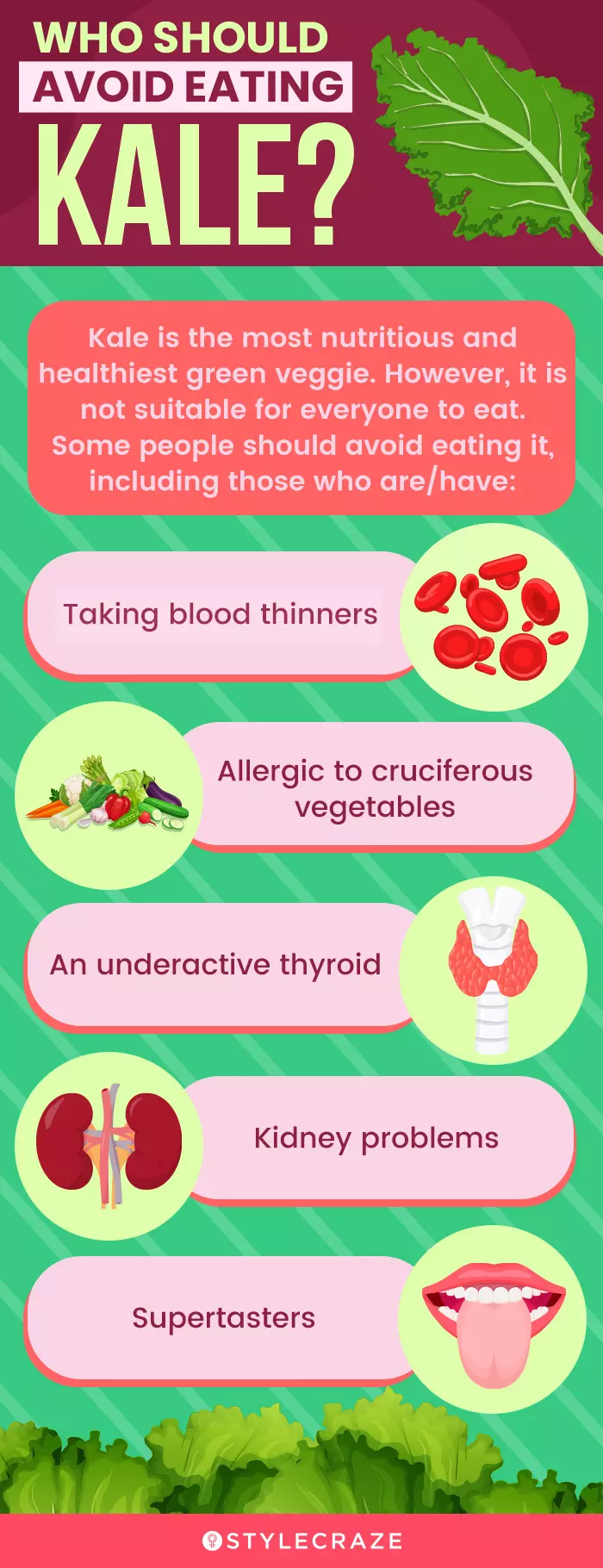
Kale is a healthy green superfood frequently used in salads and smoothies. The benefits of kale are attributed to its diverse phytonutrients and array of antioxidants, minerals, and vitamins. Kale may help boost gut, brain, bone, and heart health, and it may help reduce inflammation, enhance immunity and your vision, promote longevity, and aid in detoxification and weight loss. However, it may also cause a few side effects like allergies and diarrhea and may interfere with thyroid medications. Talk to your physician if you are unsure about taking kale.
Frequently Asked Questions
What does kale taste like?
Raw kale usually tastes bitter. Cooked kale might taste like broccoli, but even that can be bitter as well.
Can kale be eaten raw?
Yes, kale can be eaten raw and is, hence, a common ingredient in salads and smoothies. However, ensure to remove the tough stems and chop it into smaller pieces for easier digestion.
What is baby kale?
Baby kale are nothing but the delicate leaves of the young and immature plant.
What happens when you eat kale every day?
According to a study, eating kale every day can significantly lower bad cholesterol levels in the blood, improve antioxidant profile, and lower the risk of heart disease (25).
How much kale can you eat in a day?
You can have up to one or two servings of kale each day as a salad vegetable, in smoothies, or stir-fried with healthy oils (for boosting the absorption of fat-soluble vitamins).
Illustration: Benefits Of Kale, Nutrition, Recipes, Uses, And Risks
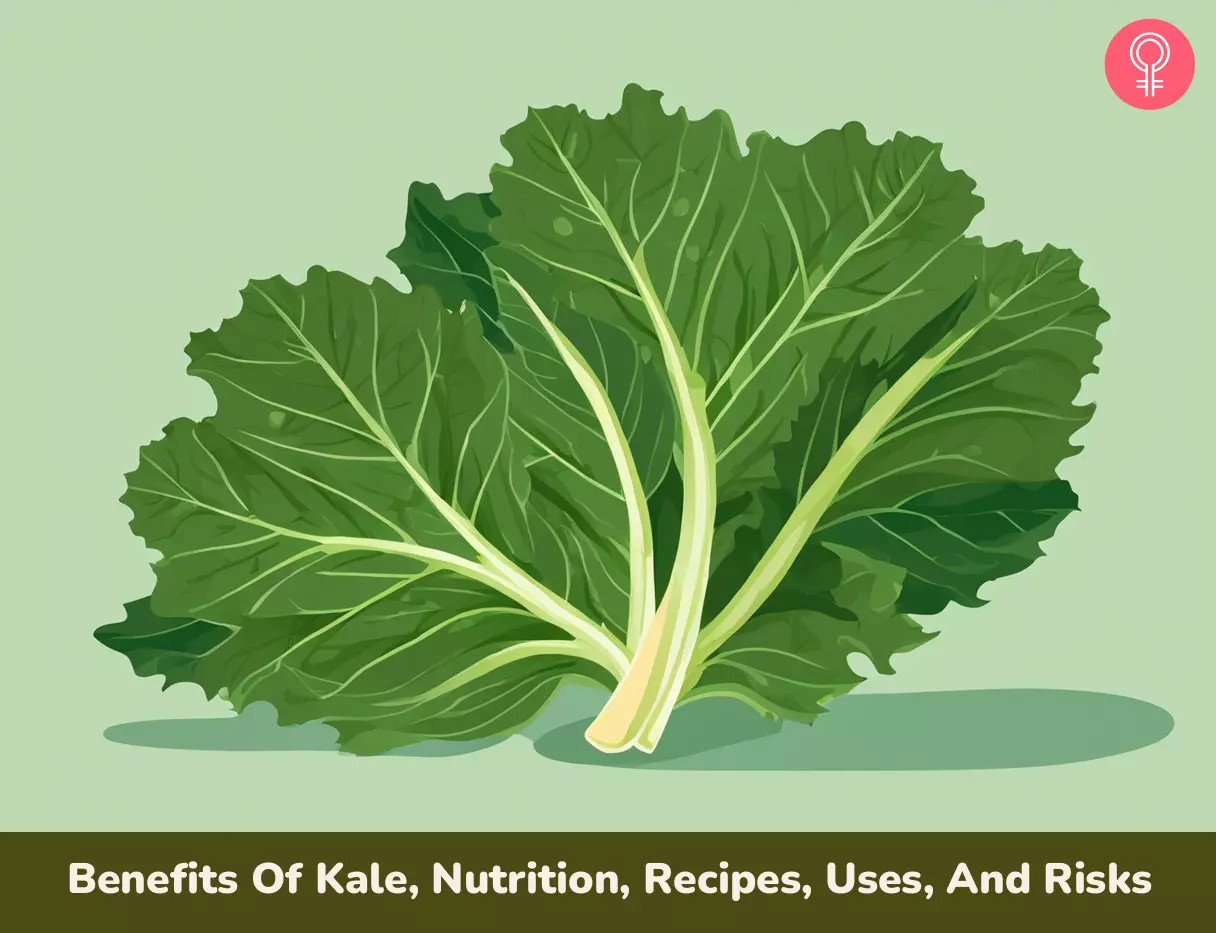
Image: Stable Diffusion/StyleCraze Design Team
Personal Experience: Source
StyleCraze's articles are interwoven with authentic personal narratives that provide depth and resonance to our content. Below are the sources of the personal accounts referenced in this article.
i. An affair with Kalehttps://livelifeonearth.wordpress.com/2013/09/21/an-affair-with-kale/
References
Articles on StyleCraze are backed by verified information from peer-reviewed and academic research papers, reputed organizations, research institutions, and medical associations to ensure accuracy and relevance. Read our editorial policy to learn more.
- “Kale, Raw”. U.S. Department of Agriculture.
- “Cruciferous vegetables and cancer prevention”. National Cancer Institute.
- “In vitro binding of bile acids…”. ScienceDirect.
- “Nutrition and Cardiovascular Health” International journal of molecular sciences.
- “Intake of kale suppresses postprandial…”. Fukushima Healthcare Center, Osaka, Japan.
- “The importance of the ration of…”. The Center for Genetics, Washington, DC, USA.
- “Prescribing Optimal Nutrition…” Arthritis.
- “Inflammation related responses…”. Luxembourg Institute of Science and Technology, Luxembourg.
- “Composition and antioxidant activity of kale…”. University of Agriculture in Krakow, Poland.
- “Protective role of…” Journal of affective disorders.
- “Plant consumption and liver health”. Sichuan University, China.
- “Vitamin A and bone health”. National Institute of Arthritis and Musculoskeletal and Skin Diseases.
- “Vision and eye health,” Center for Disease Control and Prevention.
- “Top foods to help protect your vision”. Harvard Medical School.
- “Can dark green leafy vegetables save your eyesight”. Iowa State University.
- “Role of Nuclear Factor Erythroid 2 (Nrf2)…” Antioxidants (Basel)
- “7 best foods for a healthy immune system”. CommonHealth.
- “Healthful eating is the key to weight maintenance”. Governor’s Challenge 2017.
- “Investigating Knowledge on Calcium and Preferences for Dairy vs. Plant-Based Alternatives,” National Library of Medicine.
- “Calcium Absorption from Food Products: Food Matrix Effects” Nutrients, National Library of Medicine, National Institutes of Health.
- “Iron Deficiency Anemia in Chronic Kidney Disease” Acta Haemotologica, US National Library of Medicine, National Institutes of Health.
- “Drinking carrot juice…”. Texas A&M University, Texas, USA.
- “Effects of Constant Intake…” Nippon Ganka Gakkai Zasshi
- “Functional properties of…” Food & Function
- “Kale Juice Improves Coronary Artery Disease Risk Factors in Hypercholesterolemic Men1”. Seoul, Korea.
Kale is a powerhouse of nutrition! Watch this video to learn why it’s a superfood and how it can benefit your health.
Read full bio of Dr Archana Batra
Read full bio of Ravi Teja Tadimalla
Read full bio of Arshiya Syeda
Read full bio of Sindhu Koganti







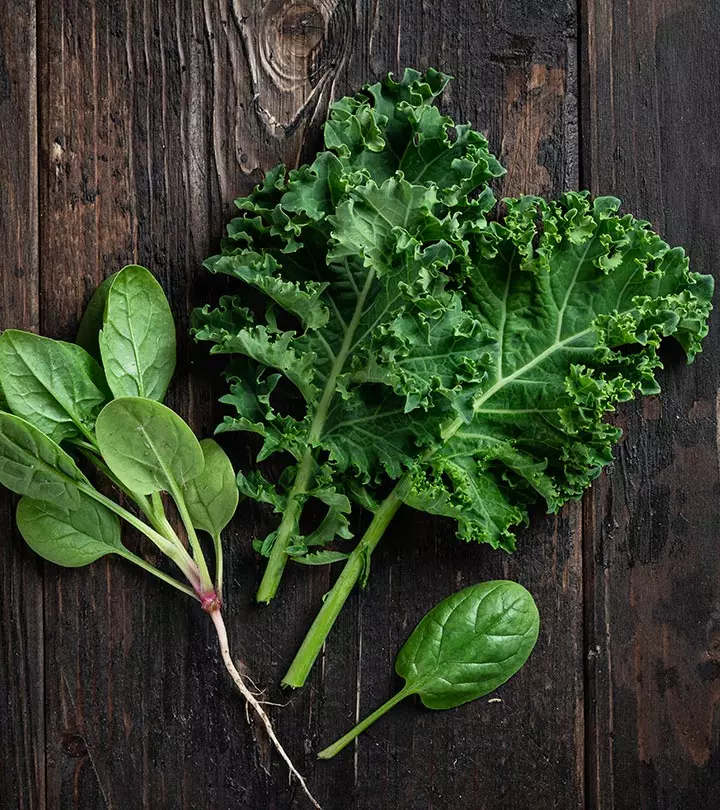
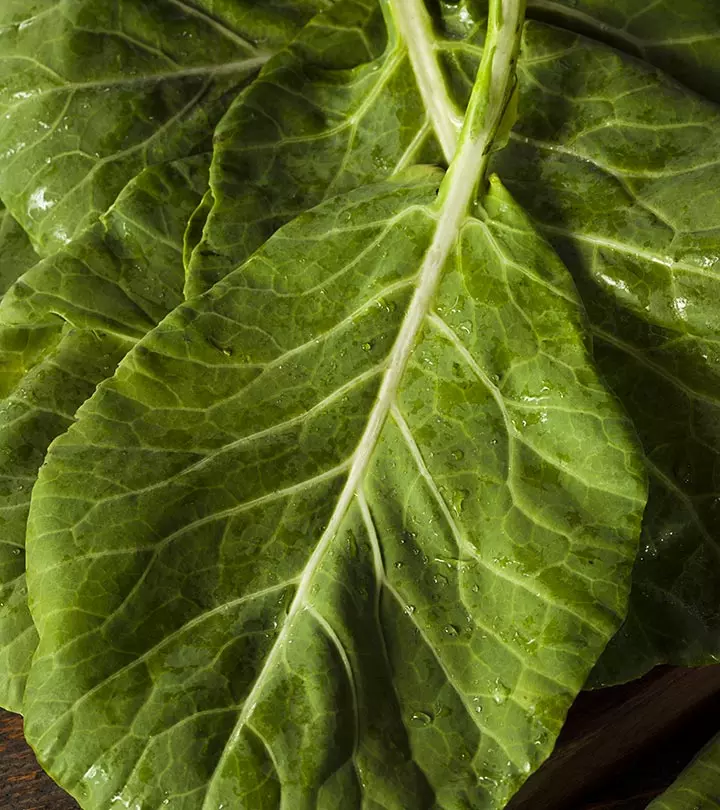
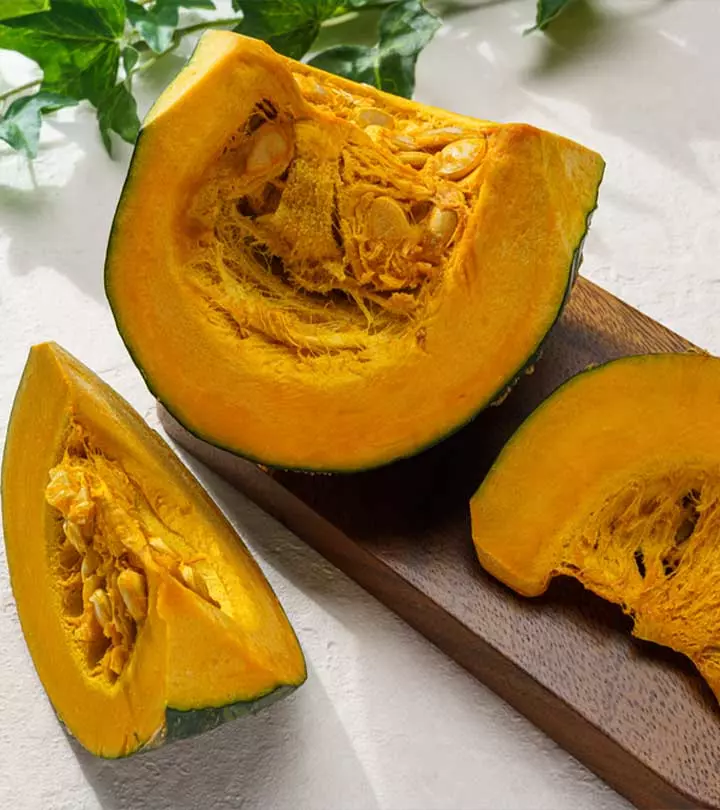
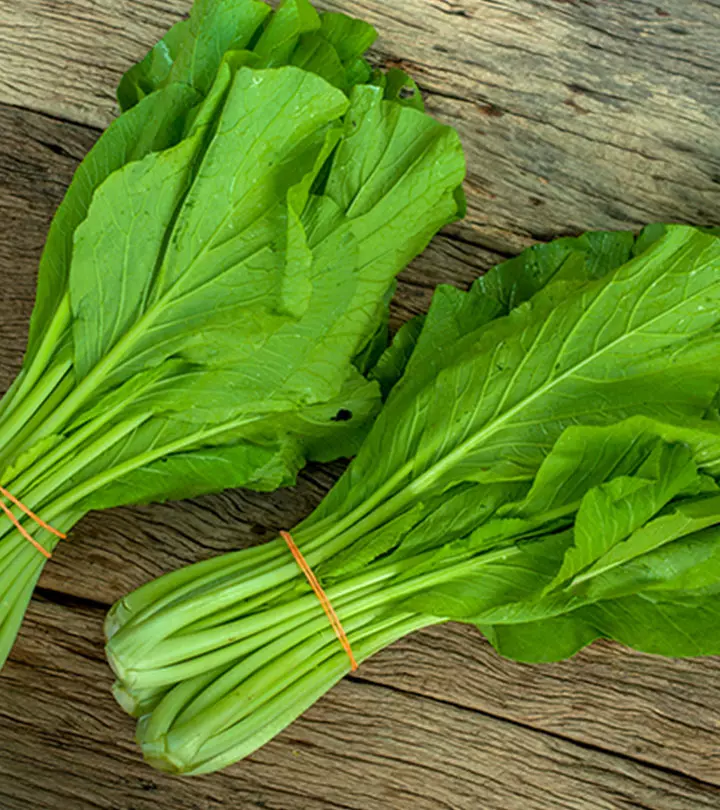
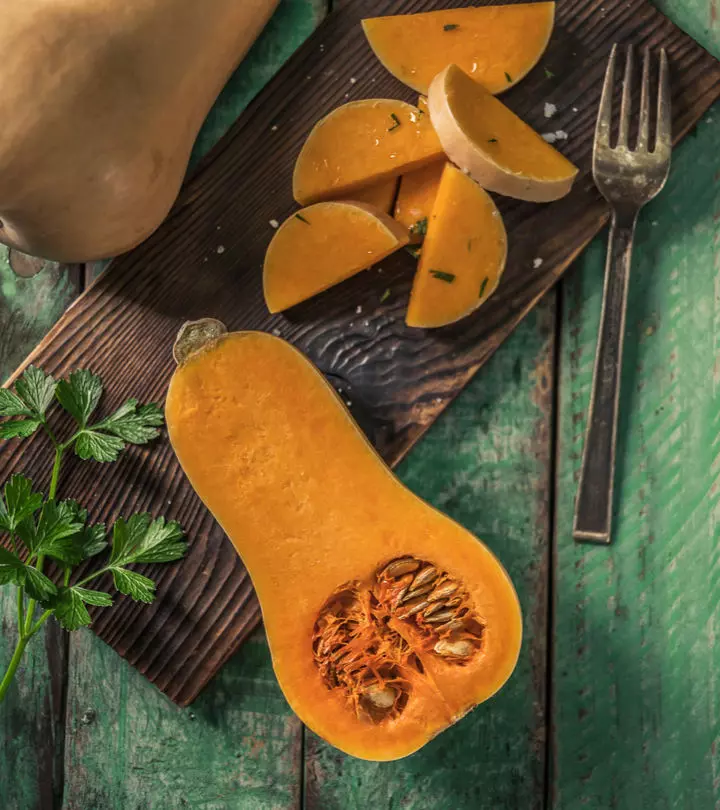

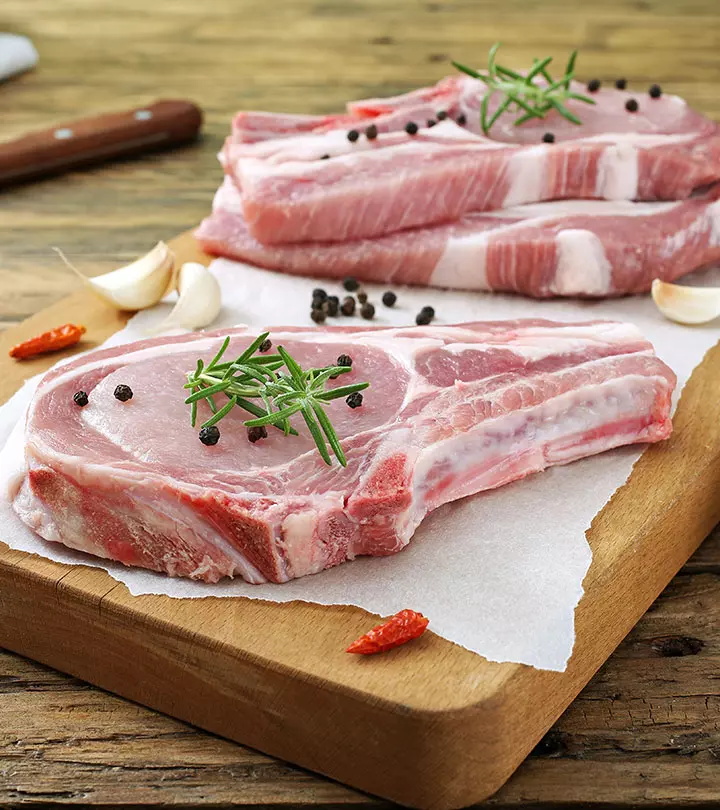
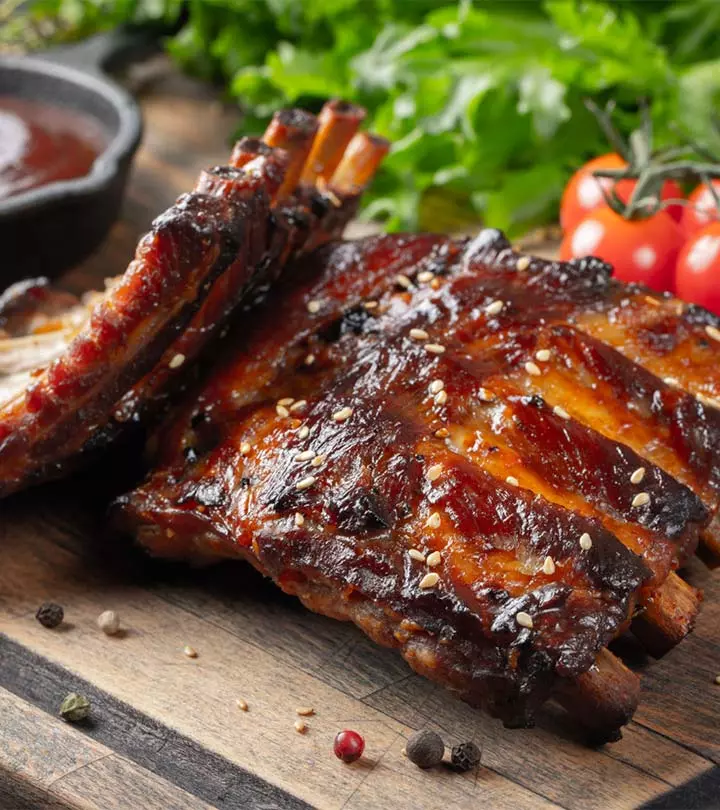
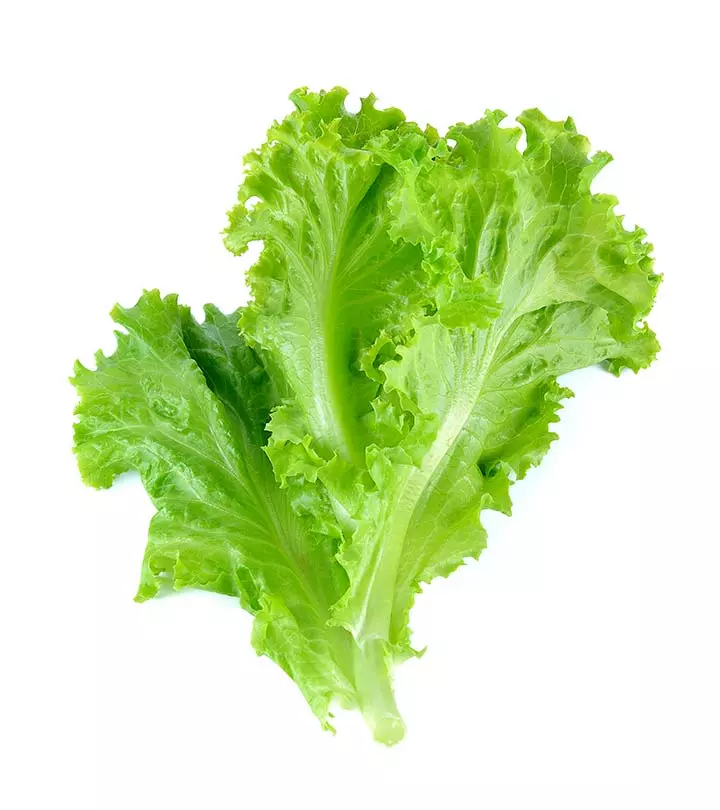
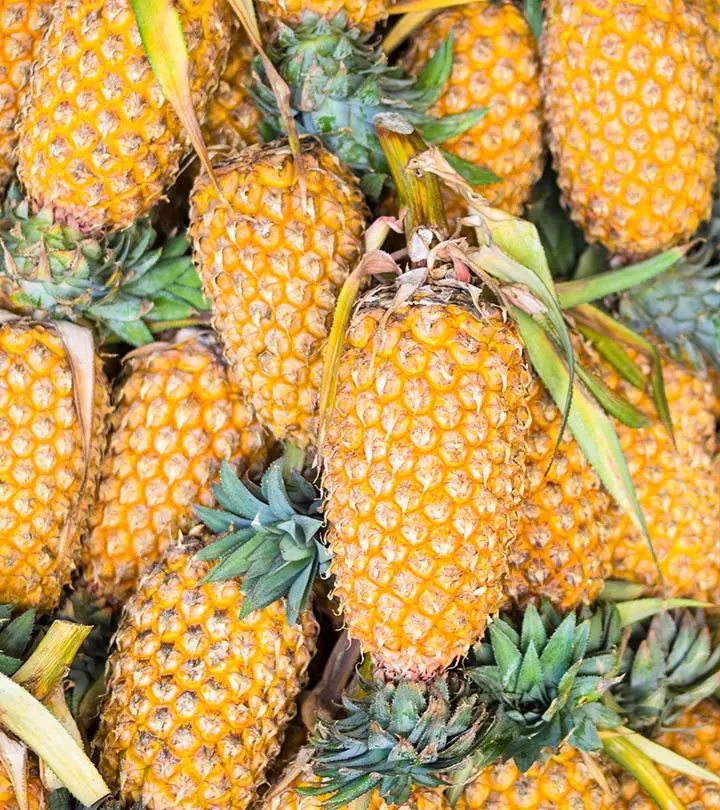
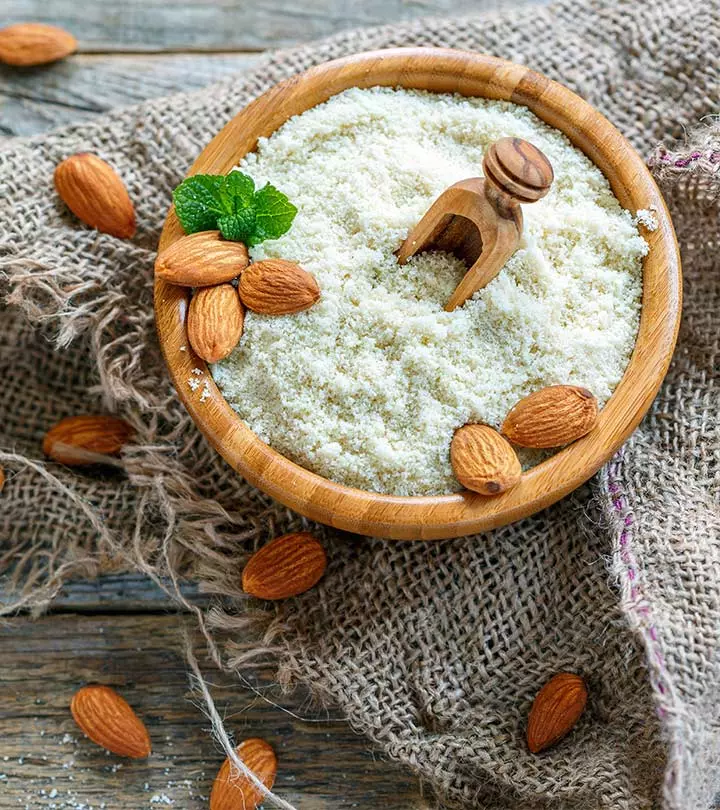
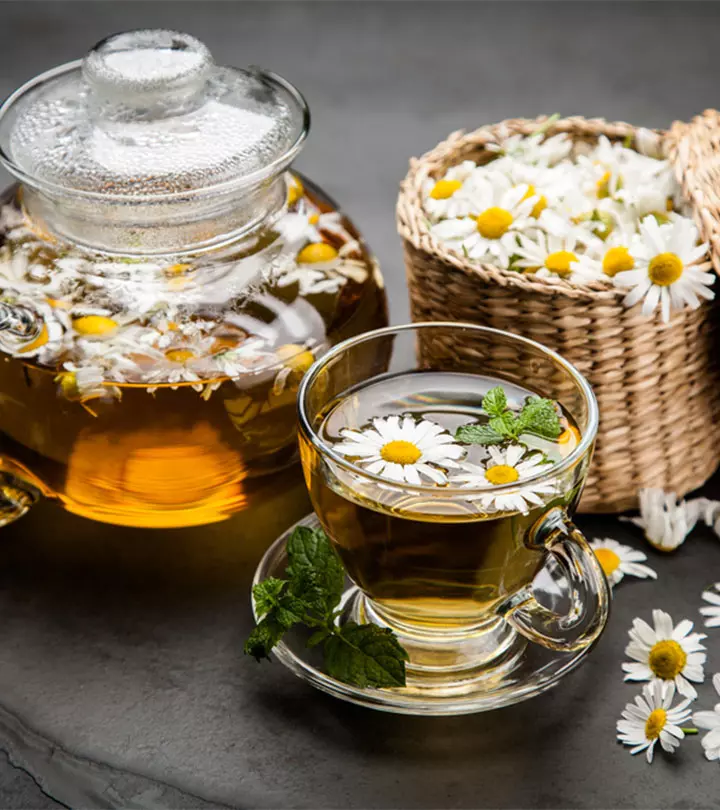

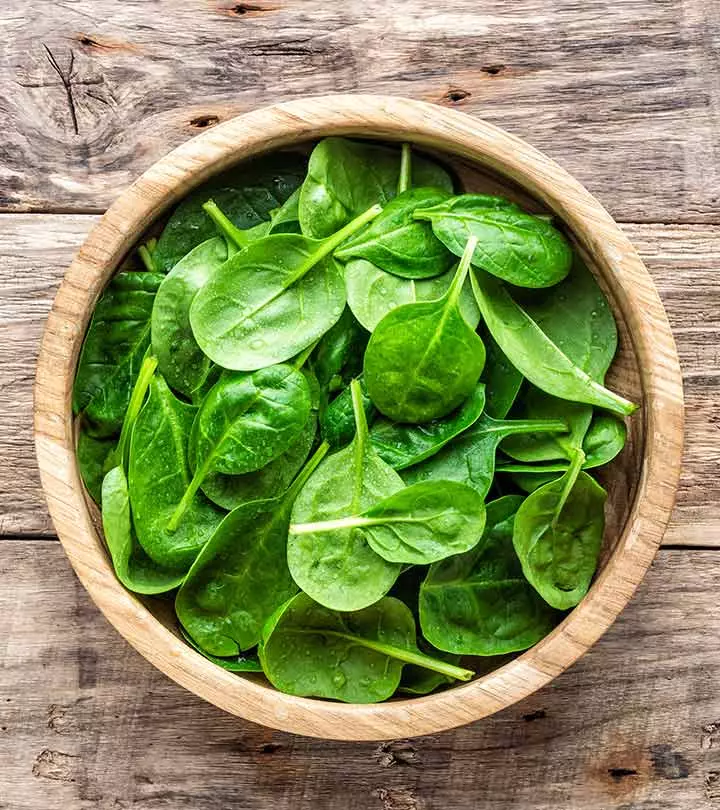
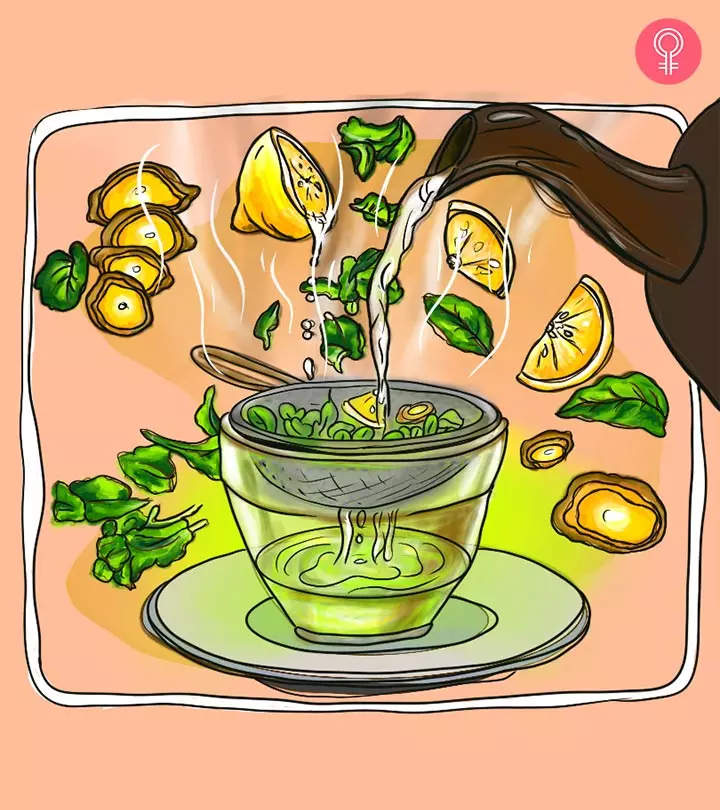

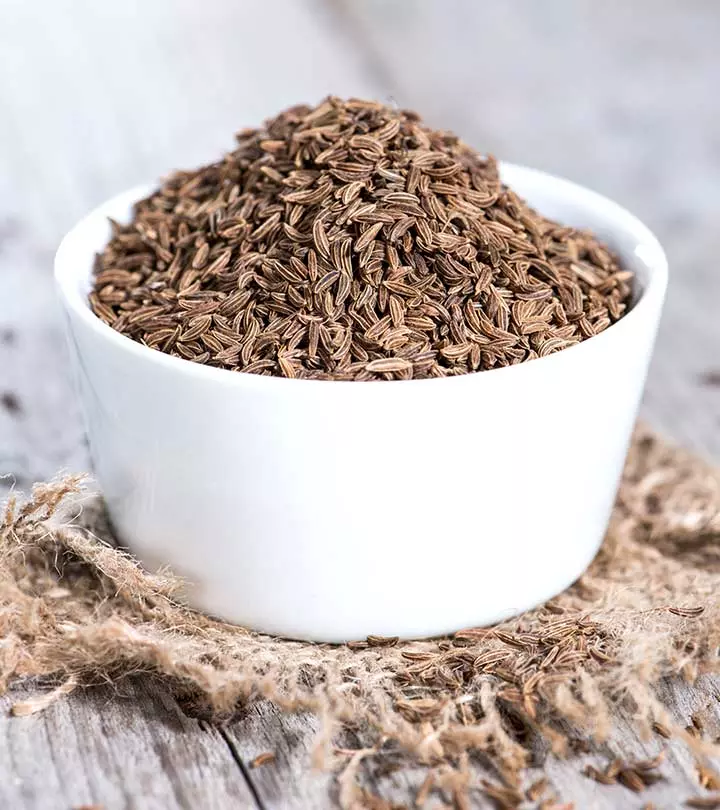
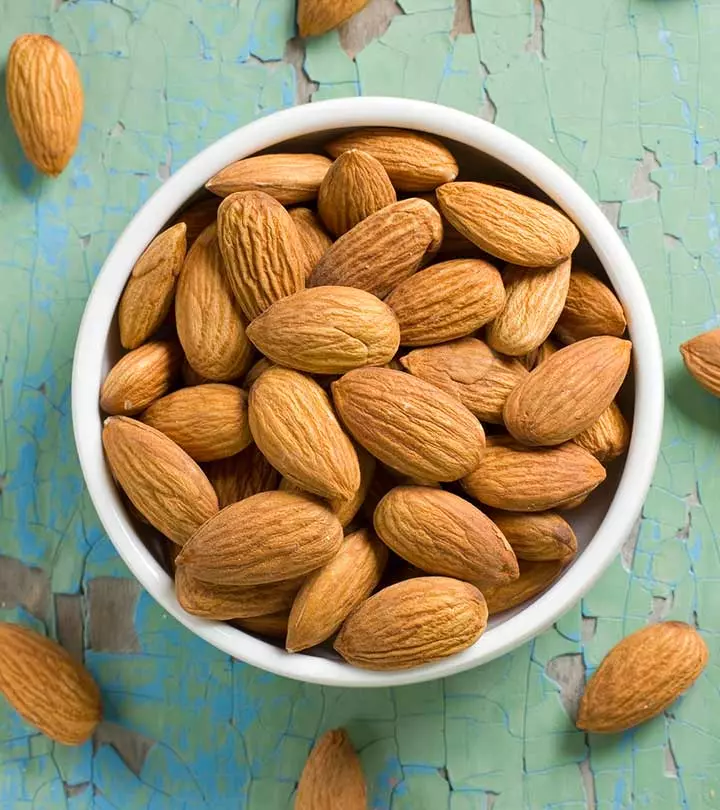
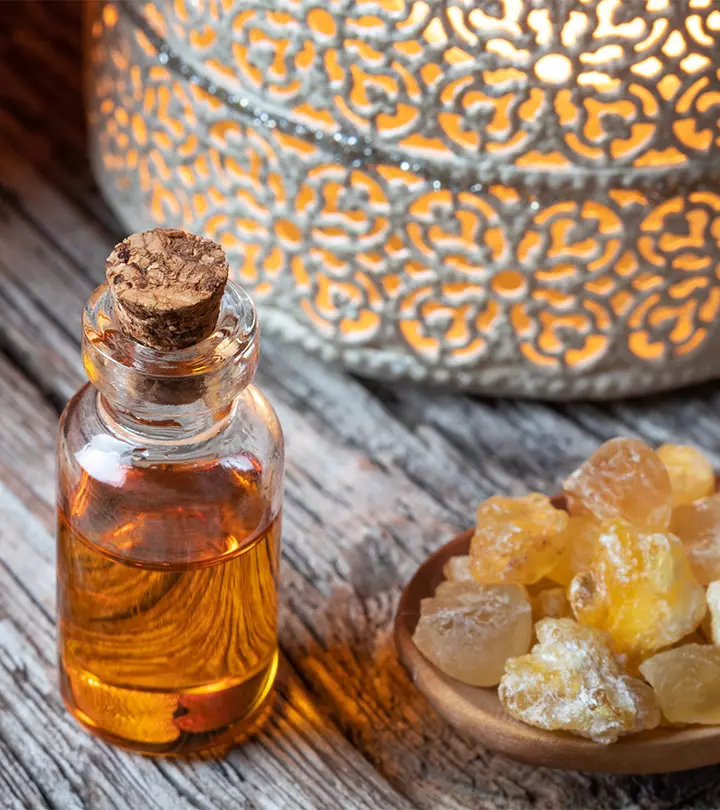

Community Experiences
Join the conversation and become a part of our empowering community! Share your stories, experiences, and insights to connect with other beauty, lifestyle, and health enthusiasts.